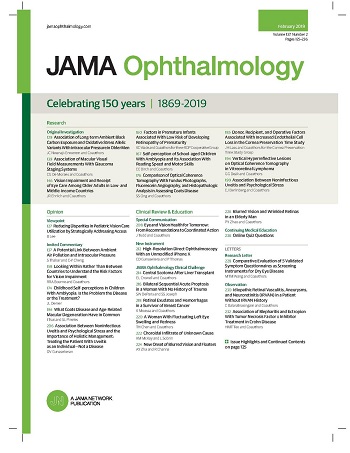胰高血糖素样肽-1受体激动剂与葡萄膜炎的风险
IF 9.2
1区 医学
Q1 OPHTHALMOLOGY
引用次数: 0
摘要
新出现的证据表明,通常用于糖尿病血糖控制的胰高血糖素样肽-1受体激动剂(GLP-1RAs)可能具有抗炎特性。了解它们对葡萄膜炎的潜在保护作用可以为新的治疗策略提供见解。目的评估GLP-1RA是否与降低葡萄膜炎发生风险相关。设计、环境和参与者:这是一项回顾性队列研究,使用2006年至2025年的电子健康记录(EHR)网络数据。采用倾向评分匹配来控制人口统计学、吸烟状况、高血压、体重指数、血红蛋白A1c和糖尿病视网膜病变分期。该分析使用了来自美国TriNetX协作网络(一个大型多中心电子病历平台)的数据。纳入了有或没有糖尿病的患者,他们服用GLP-1RAs、二甲双胍、胰岛素或钠-葡萄糖共转运蛋白2抑制剂(SGLT2is)。对照组由没有处方的患者组成。暴露GLP-1RAs,二甲双胍,胰岛素,或SGLT2is,通过处方记录确定。主要结局和测量主要结局是使用国际疾病分类(ICD)遇到诊断代码确定的非感染性葡萄膜炎的发生率。计算95% ci的风险比(rr),以评估GLP-1RA使用与葡萄膜炎风险之间的关系。分析包括整体葡萄膜炎的风险和亚型,如绒毛膜视网膜炎症、前葡萄膜炎、全葡萄膜炎和视网膜血管炎。结果本研究共纳入516052例患者,其中GLP-1RA组258 026例(平均[SD]年龄56.4[13.7]岁,女性159 025例(61.6%)),对照组258 026例(平均[SD]年龄56.4[14.0]岁,女性159 374例(61.8%))。与对照组相比,GLP-1RA组患葡萄膜炎的风险降低(RR, 0.48; 95% CI, 0.46-0.51)。这在2型糖尿病患者(RR, 0.54; 95% CI, 0.51-0.58)和无糖尿病患者(RR, 0.52; 95% CI, 0.46-0.59)中是一致的。与服用二甲双胍(RR, 0.58; 95% CI, 0.54-0.62)和胰岛素(RR, 0.57; 95% CI, 0.54-0.61)的队列相比,GLP-1RA处方对葡萄膜炎的保护作用更强。然而,与SGLT2is相比,GLP-1RAs与葡萄膜炎风险略有增加相关(RR, 1.17; 95% CI, 1.04-1.32)。与对照组相比,SGLT2i处方也与降低葡萄膜炎风险相关(RR, 0.52; 95% CI, 0.48-0.56)。结论和相关性:该队列研究发现,与对照组相比,GLP-1RA处方与较低的葡萄膜炎风险相关。这些发现表明,除了血糖控制之外,它还有潜在的抗炎作用,值得进一步研究它在眼部炎症疾病中的作用。本文章由计算机程序翻译,如有差异,请以英文原文为准。
Glucagon-Like Peptide-1 Receptor Agonists and Risk of Uveitis
ImportanceEmerging evidence suggests that glucagon-like peptide-1 receptor agonists (GLP-1RAs), commonly used for glycemic control in diabetes, may possess anti-inflammatory properties. Understanding their potential protective role against uveitis could provide insights into novel therapeutic strategies.ObjectiveTo evaluate whether being prescribed a GLP-1RA is associated with a reduced risk of developing uveitis.Design, Setting, and ParticipantsThis was a retrospective cohort study using electronic health record (EHR) network data from 2006 to 2025. Propensity score matching was applied to control for demographics, smoking status, hypertension, body mass index, hemoglobin A1c , and diabetic retinopathy stage. Data from the US Collaborative Network of TriNetX, a large multicenter EHR platform, were used in this analysis. Included were patients with and without diabetes with prescriptions for GLP-1RAs, metformin, insulin, or sodium-glucose cotransporter 2 inhibitors (SGLT2is). The control groups consisted of patients without prescriptions for each medication.ExposureUse of GLP-1RAs, metformin, insulin, or SGLT2is, identified through prescription records.Main Outcomes and MeasuresThe primary outcome was the incidence of noninfectious uveitis, identified using International Classification of Diseases (ICD ) encounter diagnosis codes. Risk ratios (RRs) with 95% CIs were calculated to assess the association between GLP-1RA use and uveitis risk. Analyses included risk of overall uveitis and subtypes such as chorioretinal inflammation, anterior uveitis, panuveitis, and retinal vasculitis.ResultsA total of 516 052 patients were included in this study, 258 026 (mean [SD] age, 56.4 [13.7] years; 159 025 female [61.6%]) in the GLP-1RA group and 258 026 (mean [SD] age, 56.4 [14.0] years; 159 374 female [61.8%]) in the control group. The GLP-1RA cohort had a reduced risk of uveitis compared with controls (RR, 0.48; 95% CI, 0.46-0.51). This was consistent among those with type 2 diabetes (RR, 0.54; 95% CI, 0.51-0.58) and those without diabetes (RR, 0.52; 95% CI, 0.46-0.59). Compared with the cohorts taking metformin (RR, 0.58; 95% CI, 0.54-0.62) and insulin (RR, 0.57; 95% CI, 0.54-0.61), GLP-1RA prescriptions were associated with greater protection against uveitis. However, GLP-1RAs were associated with a slightly increased uveitis risk vs SGLT2is (RR, 1.17; 95% CI, 1.04-1.32). SGLT2i prescriptions were also associated with reduced uveitis risk compared with controls (RR, 0.52; 95% CI, 0.48-0.56).Conclusions and RelevanceThis cohort study found that GLP-1RA prescriptions were associated with a lower risk of uveitis compared with controls. These findings suggest potential anti-inflammatory benefits beyond glycemic control, warranting further investigation into their role in ocular inflammatory diseases.
求助全文
通过发布文献求助,成功后即可免费获取论文全文。
去求助
来源期刊

JAMA ophthalmology
OPHTHALMOLOGY-
CiteScore
13.20
自引率
3.70%
发文量
340
期刊介绍:
JAMA Ophthalmology, with a rich history of continuous publication since 1869, stands as a distinguished international, peer-reviewed journal dedicated to ophthalmology and visual science. In 2019, the journal proudly commemorated 150 years of uninterrupted service to the field. As a member of the esteemed JAMA Network, a consortium renowned for its peer-reviewed general medical and specialty publications, JAMA Ophthalmology upholds the highest standards of excellence in disseminating cutting-edge research and insights. Join us in celebrating our legacy and advancing the frontiers of ophthalmology and visual science.
 求助内容:
求助内容: 应助结果提醒方式:
应助结果提醒方式:


